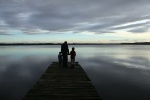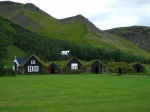Autor: Anónimo Fecha: Miercoles, 01 Enero, 2003 ⭐ Puntos 4 (2 votos)

Palm leaves dancing in the mild breeze, powder white beaches, the sound of waves breaking on a coral reef, lush, green rain forests and chirping rare birds-this is what the Andaman and Nicobar Islands essentially are. An archipelago of islands, islets and rocks, this Union Territory of India is home to some of the oldest tribes in the country. Though facilities for trekking, diving and snorkelling are available here, the best way to enjoy a trip to these islands is simply relax by the sea...
Andaman and Nicobar is a unique tourist destination not because it is dwelling on islands, but being a home of islands it has managed to keep its variety and cultural heritage in check. The main reason are the tribals who still remain aloof and untouched from the rest of the civilised world and secondly, the natural wilderness that surrounds these islands like Ozone layer. Visiting these islands and one can very well relate oneself from Robinson Crusoe. And if one lures for some water adventure then check out the corals and beaches over here. As much isolated they seem at first sight, they are the least explored and unspoilt water beauties of these islands.
Floating in splendid isolation, east of the Indian mainland is the archipelago of 572 emerald islands, islets and rocks known as Andaman & Nicobar Islands. This union territory stretches over a length of more than 700-kms. From north to south with 36 inhabited islands. Once a hill range extending from Burma to Indonesia, these undulating islands are covered with dense forests and endless variety of exotic flora and fauna.
The topography of the islands is hilly and abounds in evergreen forests. The sandy beaches on the edge of meandering coastline are fringed with coconut palms that sway to the rhythm of the sea. The sea around the islands offers excellent scope for adventure water sports. The rare flora and fauna, underwater marine life and corals, crystal clear water and mangrove lined creeks, offer a dream view of the rare gifts of nature.
The clean roads as well as unpolluted fresh air attract any nature lover, who seeks absolute peace and tranquility in the lap of Mother Nature. Adventure tourism like trekking, island camping, snorkeling, scuba diving, etc., are the major attractions here. A visit to these islands is a memorable lifetime experience.
Mythologically, the name Andaman is presumed to be derived from Hanuman, the Monkey God, who was known to the Malays as "Handuman". Since pre-historic times, these islands were the home of aboriginal tribes. The tribes of the Andaman group of islands are the great Andamanese, Onges, Jarawas and Sentinalese; all of Negrito origin, while the tribes of Nicobars, the Nicobarese and Shompens, both of Mongoloid stock.
The first settlement by the British took place in 1789, which was later abandoned in 1796. The second settlement was basically a penal settlement, taken up in 1858, after the first war of independence, followed by the settlement of convicts, "Moplas", some tribes from central and united provinces, refugees from erstwhile east Pakistan, Burma and Sri Lanka as well as ex servicemen.
In these islands people of all faiths Hindus, Muslim, Christians, Sikhs etc., and of all languages like Hindi, Bengali, Malayalam, Tamil, Telegu, Punjabi, Nicobari etc., live together in complete peace and harmony. Inter religion and inter regional marriages are common. This amazing racial and cultural mix is aptly described as 'mini-India'.
Forests are the green gold of the islands. The reserved and protected forests extend over 86% area of the territory and the forest cover is more than 92%. About 50% of the forests have been set aside as tribal reserves, national parks and wildlife sanctuaries, which are inviolate. Luxuriant mangroves, perhaps the richest in the world, occupy nearly 11.5% of the territory. More than 150 plant and animal species are endemic to these islands. The Andaman Nicobar Islands hold over 110 species of wild orchids, which is about 10% of the known Indian orchids.
The surrounding seas are equally rich in marine bio-diversity. They harbour more than 1,200 species of fish, 350 species of echinoderms, 1,000 species of Molluscs and many more other forms of life. Among Vertebrates dugong, dolphin and whale are common. Mahatma Gandhi Marine National Park is rich in Corals, varieties of colourful Fishes, Sea Turtles, etc., besides other marine life.
Andaman is also a bird's paradise. More than 246 varieties of birds inhabit the idyllic landscape, out of which 39 are endemic. Birds Megapode, Seiftlet, Hornbill and Nicobar Pigeon are mention worthy. The Avi faunal diversity has always attracted ornithologists and bird watchers to these islands.
Sandy beaches of these islands are famous for turtles nesting. Important species of turtles that are present on these islands include Leather Back Turtle, Green Sea Turtle, Hawksbill Turtle and Olive Ridley Turtle. Water Monitor Lizard, Salt-Water Crocodiles, Reticulate Python etc. are also seen here.
Corals and coral reefs are the most fascinating part of marine ecosystem here. So far 179 species of corals belonging to 61 genera have been reported. Reefs are mostly of the fringing type on the western coast. Coral reefs are important breeding and nursery ground for fish and many other organisms.
Andaman and Nicobar islands have recently been recognized as a world-class Eco-friendly tourist destination and these islands have something very special to offer to the tourists. Cellular Jail, Ross Island and Viper Island create real interest in those, who love Indian history. The Andaman tropical rainforests, beautiful silver sandy beaches, serpentine mangrove-lined creeks, marine life abounding in rare species of plants, animals, corals, etc., provide a splendid experience to the tourists.
The environment lover finds absolute ease and tranquility in the lap of Mother Nature. There is tremendous scope for enjoying the green nature, the virgin beaches, the marvels of underwater, adventure water sports ad other activities like Elephant Safari, Trekking, Lagoon Cruise, Island Camping etc.
The Andaman and Nicobar Islands has become the centre of worldwide attention thanks to the first sunrise of the millennium at Katchal, an island in the Nicobar group. Now these islands are emerging as Eco-friendly tourist destination.
Located in the Bay of Bengal, this group of 572 islands lies 193 km away from Cape Negrais in Myanmar, 1255 km from Calcutta, and 1190 km from Chennai. The two important groups of islets are Ritchie's Archipelago and Labyrinth Islands. The Nicobar Islands are located to the south of the Andamans, 121 km from the Little Andaman Island. Of the total 572 islands, only 36 islands are inhabited. The Islands are located between the latitudes 6° to 14° North and longitudes 92° to 94° East. The islands attain maximum altitude at Saddle Peak (730 m), formed mainly of limestone, sandstone, and clay.
ANDAMAN & NICOBAR ISLANDS GENERAL INFORMATION
Location : Bay Of Bengal
Capital : Port Blair
Main Attractions : Water Sports, Marine Life
Best Time To Visit : October To May
Area: Andamans District: 6,408-sq-kms
Nicobars District: 1,841-sq-kms
Total Area: 8,249-sq-kms
Distance: 1,255-kms From Calcutta (Kolkata)
1,190-kms From Chennai
1,200-kms From Vishakhapatnam
Languages Spoken: English, Hindi, Bengali, Tamil.
Altitude: Varies from sea Level to 732m
Climate: Tropical - Between 23°C (75-85 F) To 28°C (78-95 F)
Fecha: 01/Ene/2003 01:00:00
(21457 Lecturas)
 Puntos: 4 (2 votos)
Compartir:
Puntos: 4 (2 votos)
Compartir: 









